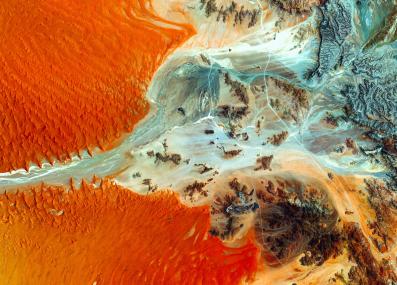Have a question?
What are the biggest challenges and innovations for new climate models?
With growing computing power, scientists hope that new models will narrow the range of possible climate futures and give a clearer picture of local and regional impacts.
April 10, 2024
Climate models can give us a preview of how humanity’s actions—or inaction—will change our planet over the coming decades and centuries. They reveal what happens to temperatures, sea levels, and other factors under different scenarios, such as if people cease creating climate pollution or if they go on with business-as-usual-emissions. But because the planet is such a complex system, they aren’t perfect: climate models have uncertainties that grow larger as they go farther into the future. Research that improves our understanding of climate physics, as well as new innovations in computing that help modelers work with enormous data sets, can shrink those uncertainties.
That will make climate scientists more confident in the precision of their long-term predictions, explains MIT professor of oceanography Raffaele Ferrari—especially when it comes to the fine details of how climate change will affect different regions differently.
Ferrari says there are two major challenges when building a reliable model of the Earth’s climate system. The first is how well scientists understand and can mathematically simulate the basic physics of the climate system, such as cloud formation, wind patterns, and ocean currents. The second is computation, because even a simplified version of an entire planet’s climate requires an enormous amount of computing power. New innovations in either field could make tomorrow’s climate models more sophisticated and realistic, Ferrari says.
It might seem like the basic mechanics that govern our climate are long-settled science. However, although the physics of air and water flow can be described down to the molecular level, that’s not true for every piece of climate physics, says Ferrari.
“Clouds clearly matter for climate, but how ice crystals and cloud droplets form, how they coalesce to form a cloud, that is what we call cloud microphysics. It gets all the way to quantum mechanics. We don't really have a perfect understanding of the process.”
Climate modelers must approximate these systems as best they can, using observations of how climate features like clouds behave in practice in place of true physical laws. These best guesses are called parameterizations, Ferrari says, “because they depend on some parameters that you don’t know.” Different climate models may set differing parameters for something like the exact relationship between clouds and moisture, which leads to variations between models. These small differences become big ones as models reach decades into the future.
Advances in computer processing have the biggest potential to reduce those uncertainties and make climate models ever more precise, Ferrari says. In fact, that’s long been the case. “If you look historically at climate models starting from the 1960s when the first climate models were developed, I would say that the largest contributor to their improved accuracy has been computer power.”
Even in the case of simple Newtonian physics, which scientists understand down to the molecule, there simply isn’t enough computing power in the world to simulate every millimeter of the atmosphere and the ocean. As a result, the resolution of even today’s state-of-the-art models is quite large—about 25 kilometers square (around 10 square miles). That’s good for broadly simulating planet-wide trends, but it means “a lot of physics falls through the cracks,” Ferrari says.
That’s where computing power can help. Climate scientists have yet to take full advantage of new computing technologies such as circuits called GPUs that can perform very-high-speed calculations. With that more powerful technology, Ferrari says, “all of a sudden you can resolve more of the physics that you understand.” There is still no way to simulate the whole planet down to the centimeter level, but advances in computing make it possible to create climate models with finer resolution, which makes their parameterizations that much less uncertain.
It’s not just about raw computing power, either. Recent leaps in artificial intelligence and machine learning also have major implications for climate models. Machine learning, at its core, is the use of large data sets to train computer models. If you apply that logic to the climate, Ferrari says, then machine learning could be set loose on climate data and figure out how to use all that historical information to calibrate the small-scale physics in climate models.
“I don't think there is anything else with the same level of complexity as climate models,” Ferrari says. “You want to represent the physics, the chemistry, and the biology of the system to a pretty high level of accuracy. Because if I wanted to know the mean temperature of the Earth within 10 degrees, you can use pretty simple basic laws. But we're asking for much more precision than that.”
Thank you to Manish Mishra of Munich, Germany, for the question.
Submit your own question to Ask MIT Climate
Get the latest from Ask MIT Climate monthly in your inbox









